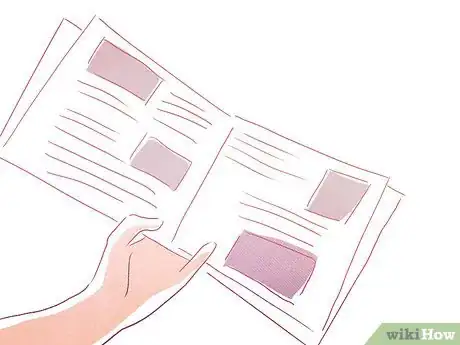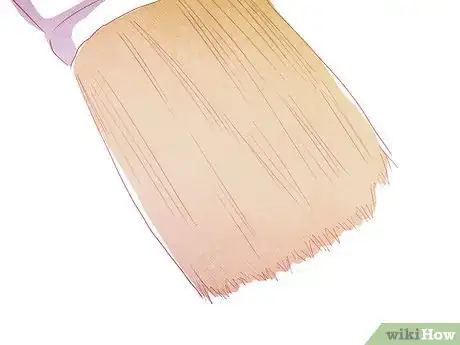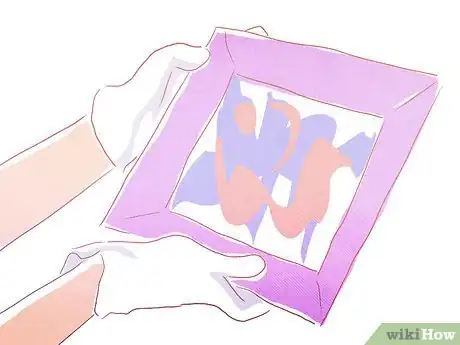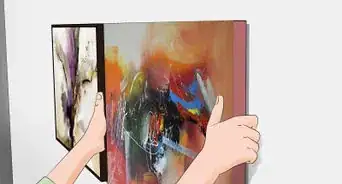X
wikiHow is a “wiki,” similar to Wikipedia, which means that many of our articles are co-written by multiple authors. To create this article, 14 people, some anonymous, worked to edit and improve it over time.
There are 8 references cited in this article, which can be found at the bottom of the page.
This article has been viewed 243,341 times.
Learn more...
If you are buying a painting for your own enjoyment, buy what you like and what feels reasonable. But buying a work of art as an investment is very different. It is not so much the art as who painted it, and the provenance: the proof of the artist's actual connection to the piece.
Steps
-
1Do your homework. Research the piece, know the artist's work, look at many of his pieces, compare signatures, get close-ups of the signature. Increasing your knowledge is critical to examining the piece and knowing what to look for when judging authenticity.
-
2Visit museums study the patinas. If you ask to see the back of a painting, the staff may show you. Examine the feel and look of old art works. Study the depth and number of layers of paint needed to achieve the color desired by the artist.[1]Advertisement
-
3Look at the front and back of the piece.
- Examine the patina of the piece itself: dirt and dust of the ages, texture, the brightness of colors, or lack thereof.
- Study the canvas, do a thread count, modern or old?
- Is there some patina on the back surface of the canvas?
- Look for anachronisms. If the canvas is stapled on the back of a 1800's piece of art, something is wrong.
-
4Look at the patina of the wood to determine whether the wood is old. Determine how the frame is put together, considering what kind of nails and hanger are used.[3]
-
5Look for bristles. Painted copies sometimes will have hairs from the cheap paint brush still in the paint on the canvas.[4]
-
6Use your nose. When you do get your hands on the painting, smell it. It takes oil a while to dry and years to completely lose the smell of oil.[5]
-
7Decide about how the piece feels to you. Balance everything, many fakes for example have no depth of paint, layers, it's easy to copy a piece electronically but a photo copier cannot get the layers of paint a real piece has.[6]
-
8Check for consistency. A fake painted copy needs everything else to match, frame wise, and a patina is hard to reproduce.
-
9Get the work appraised. If it is something you are in love with, you need a third party to independently review it, someone who is not in love. How do you know if the appraiser is reliable? He or she should have a certificate from one or more of the professional associations of art appraisers, have a history of work with the particular artist or medium or period, and preferably not be a dealer or broker of art himself. One example is Bernard Ewell, who is an expert in Salvador Dali, whose prints are often copied. Research the market history of the artist. What have other works of this artist sold for at other auction houses, this size, time frame, and same medium?[7]
-
10Note that some dealers, perhaps including those on cruise ships, may attempt to confuse the buyer with sizes and periods, even mediums to sell a lesser piece at inflated prices. Look for signature and number. For prints they must be signed, and numbered.Signed in stone is of little interest, because unlimited copies can be drawn.[8]
-
11Research the gallery. Many pieces will have gallery stickers or information written on the back. Research that gallery to learn whether it is. Look for signs of wear. There should be some signs of wear, on the frame, even the canvas sometimes. Wooden edges not quite as sharp after 50, 100 years, and drier. Research the artist for reputation. Know that some artists are known to have signed blank paper, which later have prints drawn on/from them, which means the artist did not even supervise the pulls. These would be of significantly lesser value. Salvador Dali was know to have done this,
-
12Beware of a scam where the print is not numbered but another document is, which is meaningless, as any signed in stone can be used in place of the real item.[9]
Advertisement
References
- ↑ https://www.sciencedirect.com/science/article/pii/S1369702102011409
- ↑ https://www.youtube.com/watch?v=CYYzI-Yohfk
- ↑ https://www.sciencedirect.com/science/article/pii/S1369702102011409
- ↑ https://www.artzolo.com/blog/fake-art-how-spot-one
- ↑ https://ourpastimes.com/how-to-tell-a-fake-painting-from-an-original-12236186.html
- ↑ https://www.caldwellgallery.com/original_copies.html
- ↑ http://www.tfaoi.com/aa/5aa/5aa78.htm
- ↑ http://www.gbtate.com/fakehelp.html
- ↑ https://ourpastimes.com/what-are-numbered-art-prints-12513825.html
Community Q&A
-
QuestionWhere are signatures located on very old oil paintings?
 Community AnswerUsually on the bottom right corner, although this can vary with every painter.
Community AnswerUsually on the bottom right corner, although this can vary with every painter. -
QuestionWhere can I find someone in Durant, OK, USA to appraise artwork?
 Community AnswerYou may have to contact someone in OKC. A frame shop like Pirates Alley can refer an appraiser.
Community AnswerYou may have to contact someone in OKC. A frame shop like Pirates Alley can refer an appraiser. -
QuestionHow can I determine who painted the painting?
 Community AnswerLook at the signature. If there is no signature, you may have to ask an art expert.
Community AnswerLook at the signature. If there is no signature, you may have to ask an art expert.
Advertisement
About This Article
Advertisement
































































